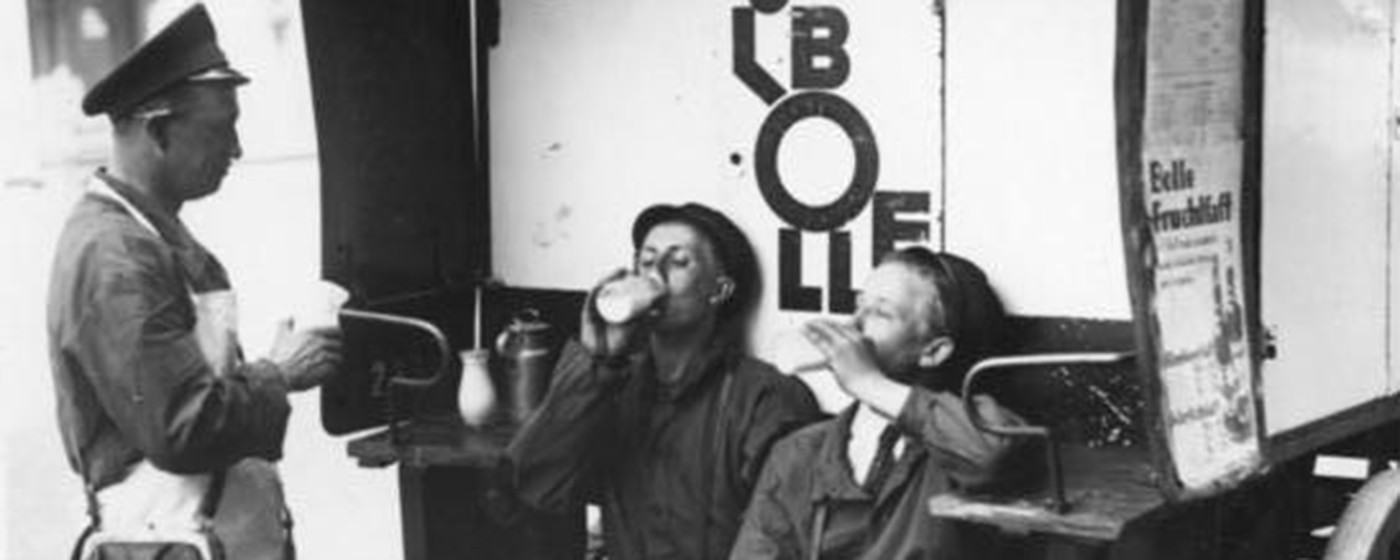Milk wars
One hundred and fifty years ago people bought fresh milk directly from local farmers. The rapidly growing demand in cities led not only to new distribution systems but also to conflicts between trading partners. From 1900 on, “milk wars” raged in several German cities.
For most of the nineteenth century, fresh milk was not a common commodity in cities. On farms, milk was mainly used for raising livestock. Only surplus milk was made into butter and cheese, and sold locally. In urban areas the low demand for fresh milk was met by cowsheds inside the city, or people bought what they needed from farmers at the edge of town. As a rule, milk was for infants and adults did not drink it on a daily basis. Fresh milk and whey were only prescribed for medical reasons and consumed, for example, by patients with pulmonary tuberculosis. Until the 1930s, consumption of milk was considered – along with meat – a sign of affluence. Milk, cream, butter and hard cheeses tended to be left off shopping lists as soon as money got tight. Moreover, it was inconceivable that men would consume milk. When the bourgeoisie launched their temperance movement and sought alternatives for alcoholic beverages, the “stronger sex” grumbled that they had no intention of becoming milksops.
The consumption of milk as a beverage did not establish itself until after 1870 – the shift resulted from new production and distribution systems, made up of farmers, dairies, retailers and processing industries. One reason for this development was the expansion of the cities. All over Europe, urbanisation and rapid population growth were leading to the breakdown of traditional forms of food supply. Milk, unlike grains, was an extremely perishable product and could not be transported far. Hygiene issues and the need to deliver it fresh limited its commercial use. Nevertheless, during the height of industrialisation, fresh milk became a very lucrative product. In 1865, a litre of milk in Berlin cost about ten pfennigs; only ten years later, it cost fifteen pfennigs; and between 1880 and World War One, the price rose to eighteen to twenty pfennigs.
Since the mid-19th century, the milk trade had become more complex in organisation: farmwomen or milkmaids who had stood at markets with their milk cans were driven out of business due to unhygienic handling or adulteration of their product, and replaced by milk depots and shops. It became increasingly common for milkmen to deliver fresh milk by horse-drawn cart to the doors of regular customers. The more astute businessmen among them started milking farms, the most radical form of product-oriented animal husbandry. As soon as a cow stopped producing milk, it was replaced. These farmers were not interested in making butter and cheese or in breeding. At the same time, industry’s general need for land forced out farms at the peripheries of the cities, which led to longer transport routes, and pushed butter and cheese prices down. Understandably, every farmer wanted to benefit from the boom for fresh milk.
With the expansion of the railway and the general improvement of transport systems, more remote farms also wanted a share of the market. Their milk was significantly cheaper, so if delivery could be organised, they rightly believed business might flourish. Yet for the most part the logistics involved were beyond the capacities of the individual farmers. Collecting fresh milk and transporting it hygienically to consumers was a huge challenge. In 1879, a farmers’ cooperative in Munich built a collection point in the countryside, which enabled their members to market their milk without middlemen. This model became so successful that, alongside private milk retailers, there were more than 1000 rural dairy cooperatives in the German Empire by 1894. Technical innovations furthered another development: the Swedish engineer Gustav de Laval built the first centrifugal separator for milk. It accelerated the process of skimming off the cream, alleviating the problem of what to do with unsold milk. The farmers wanted, of course, to sell their entire daily output, while milk retailers and dairies wanted to return unsold quantities to them.
Between 1890 and 1910, the quantity of milk transported by rail rose dramatically throughout the German Empire. In 1886, some 7 million litres of milk were delivered by rail to Dresden; by 1895 this number had risen to about 20 million litres; and by 1910, it had doubled again, to about 40 million litres. It is estimated that a similar amount was transported to the city by horse-drawn vehicles. Freight lines radiated out of the big cities like spider webs, and were constantly extended farther. The bigger a city became, the greater the distance to milk producers. In 1904, Nurnberg and Munich calculated that about 26.3 % of the fresh milk sold in their cities had travelled between 50 and 99 kilometres.
The rise in traffic led to serious logistic problems for the railways. While small express freight trains were able to transport milk cans insulated to keep cold swiftly enough to their destinations, a whole fleet of well-organized, flexible and inexpensive vehicles were required to distribute them. Milk delivery companies were founded – one of the largest was Meierei Bolle in Berlin. In 1890, it had 116 milk wagons in operation, delivering to 3000 locations. In 1891, the company had 700 employees; nine years later, 2000.
The massive inflation in the milk market led to shortages in meat production. It was a vicious cycle: since the production of less perishable dairy products was not as lucrative, everyone wanted to take part in the fresh milk market. Yet the quantity of fresh milk produced greatly exceeded the demand, which meant large quantities of unsold milk were returned to the dairies. They began investing in diversifying their products. The production range grew, with increasing numbers of producers specializing. All these factors destabilised urban milk markets. The large milk processors gradually became less dependent on the farmers and so dominant that small retailers – who had had contracts with the farmers in the surrounding area – could only survive by selling at dumping prices. They passed their losses on to the farmers who demanded their milk be sold exclusively through their own cooperatives. It was dog eat dog and in the end all the different sectors were hopelessly divided. In 1900, the term “milk war” appeared in the press for the first time. Up until 1914 and the outbreak of World War One, milk wars occurred in many cities, including Hamburg, Hanover, Dresden, Dusseldorf and Munich.
Got Milk?
Since the end of World War Two, milk consumption in the USA had been steadily declining. So in 1993, Californian milk producers decided to band together to launch a promotional campaign to boost consumption. The "Got Milk?" series came to be considered one of the world's most classic advertising campaigns.









